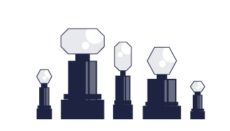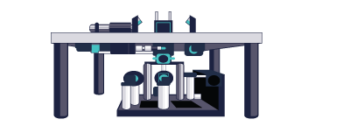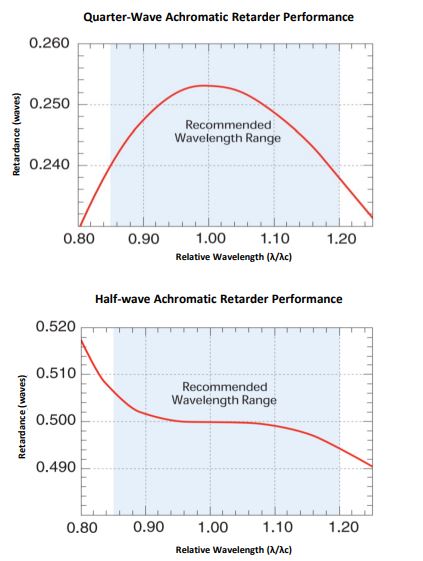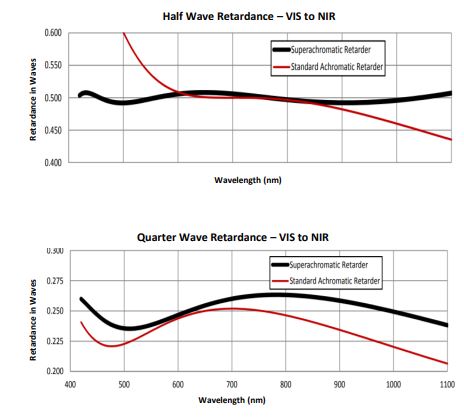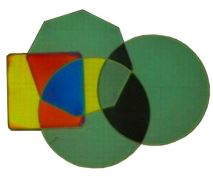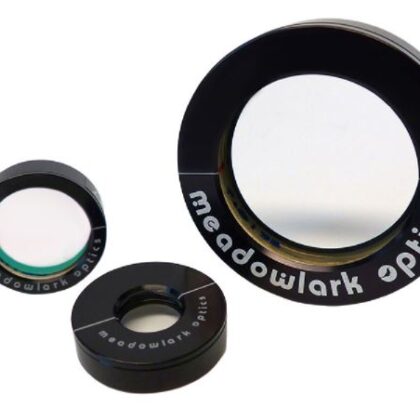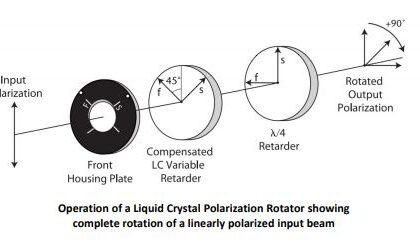Achromatic retardation performance is achieved in many different ways.
Polymers
For polymers by precisely orientating and layering several polymer sheets, these stacks are then laminated between optical flats. Achromatic polymer retarders AQ/AH Series are designed to provide nearly constant retardance over six distinct wavebands from 485nm to 1650nm. These waveplates (retarders) will experience less than 1% retardance change over a ±10° angle of incidence available unmounted or mounted in a metal ring with the fast axis clearly marked. For lower power/energy lasers with a damage threshold of 500W/cm² and 600mJ/cm² @ 20ns in the visible and 4J/cm² @ 20ns at 1064nm.
We provide retardance accurate to λ/100 for all wavelengths in the operating range
For application that require ultra-broadband coverage our Superachromatic Retarders work over two ranges. The AQS/AHS series provide quarter and half-wave retardation at 420 to 1100nm and the AQL/AHL for 800-1700nm.
Bi-Crystalline
For broadband performance Bi-Crystalline waveplates or Fresenel Rhomb prisms can be used. These achromatic retarders can span the UV, Visible, NIR and IR portions of the spectrum. Bi-Crystalline Achromats (CH/CQ & WPQW) are similar in achromatic performance to polymer achromats in the visible, but they excel in the IR. They have higher power handling capability than polymer achromats and can withstand higher storage temperatures. Their field of view is narrow compared to polymer achromats. Typically, they cannot be expected to meet their retardance accuracy for rays whose incidence angles exceed 1.5°
Two multi-order crystalline retarders, one made of crystalline quartz and the other magnesium fluoride, are combined in a subtractive mode to give an effective zero-order waveplate. By a careful choice of waveplate thicknesses, retardance dispersion is balanced to give a nearly constant retardance (in waves) over a broad range of wavelengths. The useable wavelength range is defined to give a retardance value within λ/100 of the nominal value. Custom designs with larger achromatic ranges or deeper UV wavelengths are available on request
Fresnel Rhomb Prism
Fresnel Rhomb Prism (FRB) can be used when working with broadband, multi-line or tunable laser sources. The process of internal reflection introduces a relative phase change between the two orthogonal field components. In glass a phase shift of 45° occurs at the particular angle of 54.6° and the Fresnel rhomb utilises this effect by causing the beam to be internally reflected twice, implementing a 90° (λ/4) phase change. By combining two rhombs end to end we can produce a λ/2 retardation. As the phase shift is a function of the slowly varying rhomb dispersion, the retardance change with wavelength is much lower than other types of retarder and hence can operate over a broad wavelength range. We offer holder specifically designed for mounting our fresnel rhomb waveplates. For a λ/2 plate (FRH-**2), the optical axis of the waveplate and rotation axis of the holder are aligned.










